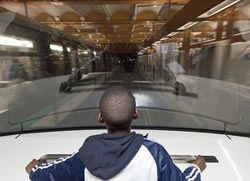Driverless Metro from the Louvre to Arc de Triomphe

Siemens is responsible for the modernization of the automation technology. The new system is more energy-efficient in operation and makes it possible to shorten the intervals between trains from 105 to 85 seconds. Line 1 trains carry up to 725,000 passengers a day, making it the most heavily traveled Metro line in Paris.
The reason Line 1 carries so many passengers is that it passes sightseeing attractions like the Louvre and the Arc de Triomphe. It would be unimaginable to even briefly interrupt service on this line, which is 17 kilometers long, so the switch to automated operation is being carried out without disrupting service.
That means installation of the control technology and the telecommunication system, fitting the rail vehicles and equipping the new control center must all take place in parallel to normal operation.
The Siemens rail automation unit's solution was to perform the work at night. At present, the old trains are being replaced, one after another. In March 2012 there were 14 driverless trains on Line 1. By early 2013 all 49 new Metro trains are to be equipped with automation technology, bringing service up to full transport capacity.
The train frequency can be flexibly adjusted as needed. Special platform screen doors ensure safety at the stations. The new trains use the Trainguard MT safety and control system, which is in service in many of the world's big cities. A subway line in New York City is also soon to be equipped with the system.
The new control system boosts energy efficiency and improves reliability: The previous system had to be left on when, for example, the trains were parked at night at a depot, in order to continually check and save data related to the vehicles' position and status. After the new system is re-started it automatically determines the position of the train by means of intelligent communication between the train and the wayside equipment.
That means it can be turned off overnight, which saves energy. And should a system go down, the train can then compute its own position on the track and also determine if another train is nearby. If the track is clear, the train automatically proceeds safely, without human hands at the controls, to the next station, where service engineers can inspect it for a possible fault. This minimizes delays due to technical malfunctions, particularly in situations where trains run very frequently.
Media Contact
More Information:
http://www.siemens.com/innovationnewsAll latest news from the category: Transportation and Logistics
This field deals with all spatial and time-related activities involved in bridging the gap between goods and people, including their restructuring. This begins with the supplier and follows each stage of the operational value chain to product delivery and concludes with product disposal and recycling.
innovations-report provides informative reports and articles on such topics as traffic telematics, toll collection, traffic management systems, route planning, high-speed rail (Transrapid), traffic infrastructures, air safety, transport technologies, transport logistics, production logistics and mobility.
Newest articles

Bringing bio-inspired robots to life
Nebraska researcher Eric Markvicka gets NSF CAREER Award to pursue manufacture of novel materials for soft robotics and stretchable electronics. Engineers are increasingly eager to develop robots that mimic the…

Bella moths use poison to attract mates
Scientists are closer to finding out how. Pyrrolizidine alkaloids are as bitter and toxic as they are hard to pronounce. They’re produced by several different types of plants and are…

AI tool creates ‘synthetic’ images of cells
…for enhanced microscopy analysis. Observing individual cells through microscopes can reveal a range of important cell biological phenomena that frequently play a role in human diseases, but the process of…





















